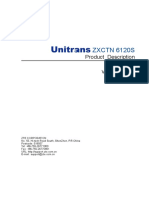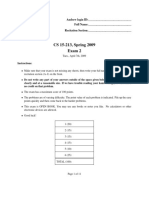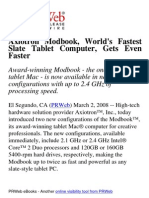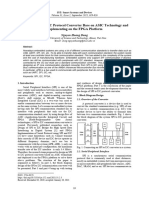0 ratings0% found this document useful (0 votes)
295 viewsCS61C Final: University of California, Berkeley College of Engineering
CS61C Final: University of California, Berkeley College of Engineering
Uploaded by
Oliver HeThe document is a CS61C final exam containing questions on various computer science topics. It includes questions on MIPS assembly, cache performance, C programming, and Gray codes. The exam has multiple choice and short answer questions testing knowledge of computer architecture, algorithms, and coding concepts. It provides 180 minutes to complete the exam which is closed book and contains questions worth a total of 120 points.
Copyright:
© All Rights Reserved
Available Formats
Download as PDF, TXT or read online from Scribd
CS61C Final: University of California, Berkeley College of Engineering
CS61C Final: University of California, Berkeley College of Engineering
Uploaded by
Oliver He0 ratings0% found this document useful (0 votes)
295 views10 pagesThe document is a CS61C final exam containing questions on various computer science topics. It includes questions on MIPS assembly, cache performance, C programming, and Gray codes. The exam has multiple choice and short answer questions testing knowledge of computer architecture, algorithms, and coding concepts. It provides 180 minutes to complete the exam which is closed book and contains questions worth a total of 120 points.
Original Description:
Answers to 2011 final exam
Original Title
2011FaCS61CFinalExamAnswers
Copyright
© © All Rights Reserved
Available Formats
PDF, TXT or read online from Scribd
Share this document
Did you find this document useful?
Is this content inappropriate?
The document is a CS61C final exam containing questions on various computer science topics. It includes questions on MIPS assembly, cache performance, C programming, and Gray codes. The exam has multiple choice and short answer questions testing knowledge of computer architecture, algorithms, and coding concepts. It provides 180 minutes to complete the exam which is closed book and contains questions worth a total of 120 points.
Copyright:
© All Rights Reserved
Available Formats
Download as PDF, TXT or read online from Scribd
Download as pdf or txt
0 ratings0% found this document useful (0 votes)
295 views10 pagesCS61C Final: University of California, Berkeley College of Engineering
CS61C Final: University of California, Berkeley College of Engineering
Uploaded by
Oliver HeThe document is a CS61C final exam containing questions on various computer science topics. It includes questions on MIPS assembly, cache performance, C programming, and Gray codes. The exam has multiple choice and short answer questions testing knowledge of computer architecture, algorithms, and coding concepts. It provides 180 minutes to complete the exam which is closed book and contains questions worth a total of 120 points.
Copyright:
© All Rights Reserved
Available Formats
Download as PDF, TXT or read online from Scribd
Download as pdf or txt
You are on page 1of 10
University of California, Berkeley College of Engineering
Department of Electrical Engineering and Computer Sciences
Fall 2011 Instructors: Dan Garcia & Michael Franklin 2011-12-15
! CS61C Final "
After the exam, indicate on the line above where you fall in the emotion spectrum between sad & smiley...
Last Name
Answer Key
First Name
Student ID Number
Login cs61c-
Login First Letter (please circle) a b c d e f g h i j k m n
Login Second Letter (please circle) a b c d e f g h i j k l m
n o p q r s t u v w x y z
The name of your SECTION TA (please circle) Anirudh Brian Eric Ian Paul Sean
Name of the person to your Left
Name of the person to your Right
All the work is my own. I had no prior knowledge of the exam
contents nor will I share the contents with others in CS61C
who have not taken it yet. (please sign)
Instructions (Read Me!)
This booklet contains 8 numbered pages including the cover page.
Put all answers on these pages; dont hand in any stray pieces of paper.
Please turn off all pagers, cell phones & beepers. Remove all hats & headphones. Place your backpacks,
laptops and jackets at the front. Sit in every other seat. Nothing may be placed in the no fly zone spare
seat/desk between students.
You have 180 minutes to complete this exam. The exam is closed book, no computers, PDAs or calculators.
You may use two pages (US Letter, front and back) of notes and the green sheet.
There may be partial credit for incomplete answers; write as much of the solution as you can. We will deduct
points if your solution is far more complicated than necessary. When we provide a blank, please fit your answer
within the space provided. IEC format refers to the mebi, tebi, etc prefixes.
You must complete ALL THE QUESTIONS, regardless of your score on the midterm. Clobbering only
works from the Final to the Midterm, not vice versa. You have 3 hours... relax.
Question M1 M2 M3 Ms F1 F2 F3 F4 Fs Total
Minutes 20 20 20 60 30 30 30 30 120 180
Points 10 10 10 30 22 23 22 23 90 120
Score 10 10 10 30
22 23 22 23 90
120
2/10
M1) Hackers Delight (10 pts, 20 min)
a) The function mystery lives at address 0xF0000000 (but mystery obviously doesnt know that). Fill in the
blanks with TAL MIPS so that mystery returns the address of itself in $v0. (Hint: you should do this part
without calls to lw or sw!)
mystery: addu $t0 $ra $0
jal here
_____________________
addiu $v0 $ra -8
here: _____________________
jr $t0
b) Lets assume you wrote part (a) correctly. Fill in the blanks so that you get the following behavior.
LookupInGreenSheet() returns the 32 bits corresponding to the MIPS function.
main() {
unsigned int *A, Baseline, mystery();
A = (unsigned int *) mystery(NULL); // argument doesnt matter, not used
lw $v0 4($a0)
A[0] = LookupInGreenSheet("___________________");
$v0 $v0 1
A[1] = LookupInGreenSheet("addiu _____________");
sw $v0 4($a0)
A[2] = LookupInGreenSheet("___________________");
A[3] = LookupInGreenSheet("jr $ra");
Baseline = mystery(A)-2; // Consider mysterys first return val (minus 2) as baseline
printf(%d\n, mystery(A) - Baseline); // 4 is printed
printf(%d\n, mystery(A) - Baseline); // 8 is printed
printf(%d\n, mystery(A) - Baseline); // 16 is printed
printf(%d\n, mystery(A) - Baseline); // 32 is printed
// etc
}
3/10
M2) Cache Money, yall (10 pts, 20 min)
The following C code is run on a 32-bit MIPS machine with a 4 KiB L1 cache with 10 offset bits. Vectors A,B,C
live in different places of memory, are of equal size (n is a power of 2 >> cache size), and are all block aligned.
AddVectors(uint8_t *A, uint8_t *B, uint8_t *C, int n) { // sizeof(uint8_t) = 1
for (int i = 0; i < n; i++)
C[i] = A[i] + B[i];
}
0 3n 1023 1
a) If the cache is direct mapped, what is the lowest _____:_____ and highest _____:_____ hit:miss ratio?
0 3n
b) If it is 2-way set-associative, what is the lowest _____:_____ hit:miss ratio?
1023 1
c) If it is 4-way set-associative (with LRU replacement), what is the lowest _____:_____ hit:miss ratio?
d) If it is 4-way set-associative (with LRU replacement), and we change the interpretation of bits from T-I-O
(tag-index-offfset) to T-O-I, and dont tell the cache, what is the worst that could happen? (in one sentence)
Nothing, since theres no I
e) If it is 4-way set- associative (with LRU replacement, and we change the interpretation of bits from T-I-O
(tag-index-offfset) to O-I-T, and dont tell the cache, what is the worst that could happen? (in one sentence)
We could get the wrong values, since a cache block is loaded assuming adjacent memory slots,
and the tags (now the lower-order 22 bits) of A[0] and B[0] could match, so when it read
B[0] it would think the block is already loaded and read some other byte of that block
thinking it was B when it was really As data.
4/10
M3) Got some numbers, down by the C! (10 pts, 20 mins)
a) Fill in the blanks of this C code to write a 1 to every byte of a single 2 KiB page on the heap, dont write
anything to any other pages. You may assume that there are a few available heap pages. Use as little
memory as possible (you might need to ask for more than 2 KiB). memset is not allowed, you cant allocate
anything already allocated on the heap, and two consecutive memory requests may not be near each other.
800
#define PAGE 0x___________ // 2 KiB in hex
TouchEveryPageByte() {
uint8_t *ptr, *tmp;
ptr = (uint8_t *) malloc (2 * PAGE);
__________________________________________________ // one C statement here
tmp = (ptr | (PAGE-1)) + 1;
__________________________________________________ // one C statement here
for (int i = 0; i < PAGE; i++)
*(tmp+i)
_____________________________________ = 1;
}
b) Here are 3 different numerical encodings of 32 bits.
Float Fixed point Rational
float XXXXXXXXXXXXXXXX.YYYYYYYYYYYYYYYY
!where Xs are interpreted as 2s
complement, Ys are interpreted the
standard way bits on the right of a fixed-
point representation are interpreted.
NNNNNNNNNNNNNNNNDDDDDDDDDDDDDDDD
!where Ns are interpreted as a biased numerator
(the bias is set in the usual way so that roughly half
the numerators are positive, half are negative), and
Ds as an unsigned denominator. A denominator of
0 means infinity; if both num and denom are zero
its a NaN. This # basically looks like:
NNNNNNNNNNNNNNNN <- biased
----------------
DDDDDDDDDDDDDDDD <- unsigned
Rank these three in terms of the following categories (ties are allowed). We did the first two for you.
Float Fixed Point Rational
Distance from A of first
letter in name
1
st
1
st
2
nd
Fewest # of letters in name 1
st
3
rd
2
nd
Fewest number of zeros 2 (2) 1 (1) 3 (2^16)
Smallest positive number 1 (2^-149) 2 (2^-16) 2 (2^-16)
Closest representable
number to -1/3
2 (23 bits close)
3 (16 bits close) 1 (exact)
Actual number farthest to
the left on the number line
1 ~(- 2^127) 2 (- 2^15) 3 (- 2^15-1)
5/10
F1) Code, Earl Gray, Hot! (22 pts, 30 mins)
Bits can mean anything! Gray codes are a way of ordering the binary encoding of symbols/values such that
successive symbols/values only differ by exactly one bit in their representation. (Gray codes are useful for error
correction in digital communication!) As an example, heres one of many possible valid orderings of the four-bit
Gray codes (with the consecutive differing bits underlined):
0000, 0001, 0011, 0010, 0110, 0111, 0101, 0100, 1100, 1101, 1111, 1110, 1010, 1011, 1001, 1000
Any cycle of this sequence will also be a valid ordering, just so long as no code differs
more than one bit from its neighboring codes. When two binary representations differ
by exactly one bit, we call the pair Gray adjacent.
a) Annotate this cube such that each corner is Gray-adjacent to its 3 neighbors.
(Corner a is given.)
a 000 b ___ c ___ d ___ e ___ f ___ g ___ h ___
Now imagine a one-bit stream of data, from which were constantly assembling two-bit values. We use the bit
received at time t, b
t
, in conjunction with the previously streamed-in b
t-1
to make the code b
t
b
t-1
. Note that the
most recent bit is the more significant. We want a finite state machine that indicates whether the two most recent
two-bit values that is to say b
t
b
t-1
and
b
t-1
b
t-2
, are Gray code adjacent. (Take
two zeros as the initial condition of the
stream if we stream in bit b
0
at t = 0,
the three most recent bits weve seen will
be taken as b
0
00, giving us the values
b
0
0 and 00.) Heres an example for
the bit-stream 1101 (with our initial
condition bits bracketed):
b) Lets presume a state variable such that the three most recent bits are Input, (Current) S
2
, (Current) S
1
(telling us that the next state bits must be Input, (Current) S
2
). Fill in the Output column of the table.
c) Add the state transition arrows, along with the input
and output bits on each transition, to the state
diagram below. One is done for you, as well as an
arrow for the 00 initial condition:
a) Give the simplest Boolean expression for Output in
terms of Input, (Current) S
2
, and (Current) S
1
.
Show your work.
Input Most recent 3 bits Most recent codes Adjacent? Output
1 1[00] 10 and 00 Yes 1
1 11[0] 11 and 10 Yes 1
0 011 01 and 11 Yes 1
1 101 10 and 01 No 0
Input
Current
S
2
Current
S
1
Next
S
2
Next
S
1
Output
0 0 0 0 0 0
1 0 0 1 0 1
0 0 1 0 0 1
1 0 1 1 0 0
0 1 0 0 1 0
1 1 0 1 1 1
0 1 1 0 1 1
1 1 1 1 1 0
6/10
F2) V(I/O)rtual Potpourri ! (23 pts, 30 mins)
Consider a system with 1 GiB of physical memory, a 32-bit virtual address space, and 2 KiB pages.
a
1
) How many bits to uniquely identify each page of virtual memory? ________ Physical memory? ______
2
32
virt. addrs, 2
11
byte pages # 32 11 = 21 bits
2
30
phy. addrs, 2
11
byte pages # 30 11 = 19 bits
a
2
) How many entries does the page table contain? ________
2
21
The following code runs on the above system. arr
is an integer array of size ARRAY_SIZE. SKIP is a
positive integer less than or equal to the page size.
32 page faults were detected while running the
loop, all due solely to reading from arr.
for(int i = 0; i < ARRAY_SIZE; i+=SKIP)
total += arr[i];
b
1
) Whats the smallest possible value of ARRAY_SIZE? ________
2 + 30*2
9
b
2
) The TLB for this system has four entries, each listing a single VPN-PPN pair, and it uses an LRU
replacement policy. In the middle of running the above code, another process was given CPU time but
for some reason an entry of the TLB didnt flush during the switch to this process. This unflushed entry
corresponds to a page filled with elements of arr. Both processes executed without raising an
exception. Why might total be incorrect? At worst, how many incorrect values were added to total?
The other process might have performed writes to memory at virtual addresses that match
those used by array elements living on the unflushed page. At worst, (2KiB)/(SKIP)
incorrect values were added.
b
3
) Assume we are using RAID 1 for this systems disk, and the above scenario unfolds.
How many pages on disk would have been modified in the best case? ________ Worst case? ______
None
64
c) In which situations might some form of DMA be used? Check all that apply.
Handling a page fault _X__
Communication between servers in a datacenter _X__
Playing music from a file already in memory ___
Scrolling through a (fully downloaded) web page _X__
d) Explain (in the provided space) how, why or when the statements below are true:
Statement Justification
Polling can be faster than interrupt-
driven I/O.
Polling has no overhead in the way that interrupt handling
requires a context shift
High frequency polling is
undesirable.
High frequency polling requires lots of wasted CPU time
and power waiting for the I/O data to become valid
Low frequency polling can make
data transfer slow.
If the device fills up its buffer faster than its polled out, data
needs resending
7/10
I/O interrupts can be combined with
I/O polling to get the best of both.
Interrupts can tell the system when a burst of I/O data has
begun, and polling can be used subsequently until the burst
of data is over (requiring less interrupt overhead losses)
e) We have a system to which we can instantaneously add and remove cores adding more cores never
leads to slowdown from things like false sharing, thread overhead, context switching, etc. When the
program foo is executed to completion with a single core in the system, it completes in 10 minutes. When
foo is run with a total of three cores in the system, it completes in 6 minutes. How long would it take to
execute foo on this magical system as the number of cores approaches infinity?
The speed up from 1 to 3 nodes suggests 60% of foo() is parallelizable,
so Amdahls law
suggests a maximum speed
up of 2.5x over the single
core in the limit
meaning foo would take
4 minutes.
F3) Datapathology ! (22 pts,
30 mins)
Consider the single cycle datapath as it
relates to a new MIPS instruction,
save and duplicate:
sdup rt, rs, imm
The instruction does the following:
1) Stores the value in rs into memory at the address stored in $sp, offset by imm.
2) Copies the value in rs into rt.
Ignore pipelining for parts (a)-(c).
a) Write the RTL corresponding to sdup rt, rs, imm
R[rt] $ R[rs]; Mem[R[$sp] + imm] $ R[rs]
b) Change as little as possible in the datapath above (draw your changes right in the figure) to enable
sdup. List all your changes below. Your modification may use muxes, wires, constants, and new control
signals, but nothing else. (You may not need all four provided boxes.)
(i) Add a mux to select rs or $sp for Ra
(ii) Add a mux to select etiher rs or rt for Rb
(iii) Instead of the busW line, add a mux to select between busB and (new line) busW
(iv) A new control signal sdup to control all the above muxes
c) We now want to set all the control lines appropriately. List what each signal should be, either by an intuitive
name or {0, 1, dont care}. Include any new control signals you added. Dont allow sdup to
access any memory below the stack pointer.
8/10
RegDst RegWr nPC_sel ExtOp ALUSrc ALUctr MemWr MemtoReg sdup
0 1 +4 Zero imm add 1 X 1
d) Now consider sdup run on the 5-stage MIPS pipeline. Consider the following pairs of instructions (i)
through (iii) independently. Circle each pair that poses a data hazard.
For each circled pair, explain how to resolve the hazard.
If stalling is needed, provide the number of stall cycles required. (Please resolve the hazard with a
minimal number of stall cycles.)
If forwarding is needed, state after which stage the data is available and at which stage the data is
needed.
add $sp $sp -8
sdup $t0 $a0 0
add $t0 $t0 $t1
sdup $t0 $a1 4
lw $t0 0($a1)
sdup $t1 $t0 0
9/10
F4) http://inst.eecs.berkeley.edu/~parallel ! (22 pts, 30 mins)
Berkeley is looking at opening CS61C to the masses - but the glookup service is far too slow! In addition to
ordering more servers, the inst staff have asked you to look at optimizing the glookup service. They've already
determined that spinlocks are a performance issue, but there's no way to replace them. Perhaps you can make
the locks themselves faster, though! You identify two possible definitions for a spinlock:
typedef struct spinlock {
char value; // 1 if the lock is currently held else 0
} spinlock_t;
typedef struct spinlock_padded {
char value; // 1 if the lock is currently held else 0
char padding[63]; // 63 bytes of padding (never used)
} spinlock_padded_t;
a
1
) Implement the generic spin_lock and spin_unlock functions in C, which will be called on pointers to
spinlock_t and spinlock_padded_t. You use the following test-and-set function:
int CAS(char *dest, char test, char value)
CAS compares the values of *dest and test:
If theyre equal, *dest is set to value, and CAS returns 1
If not, CAS returns 0, changing nothing in the heap
State any assumptions you need to make.
void spin_lock(void *lock) {
while ( ! CAS(lock, 0, 1)) // Until
the lock can be set
; // do nothing
}
void spin_unlock(void *lock) {
((char*) lock) = 0;
}
You evaluate the performance of both types of spinlocks using two different parallelism benchmarks. They are
both locked and unlocked using the same generic spin_lock and spin_unlock procedures.
a
2
) On one benchmark, the padded spinlock worked faster. Why might this be? Describe what the program could
be doing to cause this.
With unpadded locks, if two adjacent memory locations are associated with two different spin locks, two
threads could try and poll each location sequentially, and false sharing can result. The larger padded lock
causes each spinlock memory location to be spread apart from the others.
a
3
) On the other benchmark, the unpadded spinlock worked faster. Why might this be? Describe what the
program could be doing to cause this.
If the benchmark allocates many spinlocks per thread, it can be faster to have a single threads locks all fit
in the same cache blocks in to improve the cache hit rate.
Part of the glookup upgrade includes some convenient and speedy statistical reporting. The system has exactly
one record for each student of the following format:
(Student Name, Students Advisors Name, Students Course Load)
where course load encodes the number of credits the student took in the most recent semester. To get a sense
of which faculty are pushing students to take more or fewer classes, the administration have asked inst to ask
you to write a MapReduce scheme for finding, for each advisor, the greatest course load any of that advisors
students are taking. The output record should resemble: (Advisor Name, Max Course Load)
b
1
) Describe the process by which your mappers would read an input record and produce fodder for the reducers.
10/10
Please explicitly include the (key, value) pairs your map() function would emit.
For each record the mapper sees, remove the students name and just echo the advisor name (output key)
and course load (output value)
(key, value): ( ______Students Advisors Name______ , ______Course Load____________ )
b
2
) Describe how your reducers would transform the pairs received from the mappers into the output records.
You might also like
- VSX Training Guide V2 PDFDocument23 pagesVSX Training Guide V2 PDFEdwin MolinaNo ratings yet
- CS61C Midterm: University of California, Berkeley College of EngineeringDocument7 pagesCS61C Midterm: University of California, Berkeley College of Engineeringr_k_sNo ratings yet
- Midterm SolutionsDocument16 pagesMidterm SolutionsboomerNo ratings yet
- DLD McqsDocument36 pagesDLD Mcqspunjabiangem100% (6)
- Manual Ticket Printer - FutureLogic GEN2 (PSA-66-ST2R) 2.0Document16 pagesManual Ticket Printer - FutureLogic GEN2 (PSA-66-ST2R) 2.0Marcelo LambreseNo ratings yet
- Manual 6120sDocument116 pagesManual 6120skank riyan100% (1)
- CS61C Final Exam : University of California, Berkeley - College of EngineeringDocument8 pagesCS61C Final Exam : University of California, Berkeley - College of EngineeringjuggleninjaNo ratings yet
- Csci 260 Study Guide-4Document10 pagesCsci 260 Study Guide-4zubayerthewizardNo ratings yet
- MergedDocument33 pagesMergedSteven TruongNo ratings yet
- Hong Kong University of Science & Technology Computer Organization (COMP 180)Document11 pagesHong Kong University of Science & Technology Computer Organization (COMP 180)Tamzid HabibNo ratings yet
- 2223sem2 CS2100Document11 pages2223sem2 CS2100Runjia ChenNo ratings yet
- Coal Final Solved Spring 2018 Fast LhrDocument10 pagesCoal Final Solved Spring 2018 Fast LhrMãârîj ÎmräñNo ratings yet
- Exam2 f10 PDFDocument15 pagesExam2 f10 PDFajgeminiNo ratings yet
- Exam1 f09 v1Document18 pagesExam1 f09 v1rjzmbmNo ratings yet
- October 2012: Questions Must Be Answered in Accordance With The FollowingDocument31 pagesOctober 2012: Questions Must Be Answered in Accordance With The FollowingAndrew CordonNo ratings yet
- CS61C Midterm : University of California, Berkeley College of EngineeringDocument17 pagesCS61C Midterm : University of California, Berkeley College of EngineeringjuggleninjaNo ratings yet
- ITCS 321 Test ONE OCT2019 KEYDocument5 pagesITCS 321 Test ONE OCT2019 KEYt69mdtd6z7No ratings yet
- ITCS 321 Test ONE NOV 2018 KEY AAADocument5 pagesITCS 321 Test ONE NOV 2018 KEY AAAt69mdtd6z7No ratings yet
- Cse AssignmentDocument9 pagesCse AssignmentSai sasindhar MalapatiNo ratings yet
- COAL Final Spring 2018 FAST LhrDocument10 pagesCOAL Final Spring 2018 FAST LhrMãârîj ÎmräñNo ratings yet
- Final Practice Questions Set 1Document8 pagesFinal Practice Questions Set 1Kairi SameshimaNo ratings yet
- Lab 1.5.9: Converting Numbers Overview: Estimated Time: 25 Minutes ObjectiveDocument5 pagesLab 1.5.9: Converting Numbers Overview: Estimated Time: 25 Minutes ObjectiveHamzaSpahijaNo ratings yet
- Grupa: . Nume/prenume .Document4 pagesGrupa: . Nume/prenume .AndreiNo ratings yet
- RT-1 Mat Cs(Ch1,2) AnsDocument4 pagesRT-1 Mat Cs(Ch1,2) AnsarunsanthoshmanoNo ratings yet
- Digital Logic DesignDocument126 pagesDigital Logic Designmt21215015 Navdeep GuptaNo ratings yet
- Grade 11 Computer Science HY - QPDocument6 pagesGrade 11 Computer Science HY - QPRakshith VijayanandNo ratings yet
- Translated 2222Document9 pagesTranslated 2222MOHAMMAD CHAMSEDINENo ratings yet
- Programing in C - A Study MaterialDocument90 pagesPrograming in C - A Study Materialanon_977979805No ratings yet
- COS 217 Midterm Exam AnswersDocument9 pagesCOS 217 Midterm Exam AnswersloyalwatchNo ratings yet
- JagaDocument6 pagesJagaSai sasindhar MalapatiNo ratings yet
- 2013 April (Q)Document32 pages2013 April (Q)WachichaoOahcihawNo ratings yet
- C Questions and AnswersDocument29 pagesC Questions and AnswersPunitNo ratings yet
- Basic Integer OverflowsDocument13 pagesBasic Integer OverflowsMarcos Paulo FerreiraNo ratings yet
- Sequential Prog. Lec 1Document39 pagesSequential Prog. Lec 1aabdurrahaman647No ratings yet
- Gate Information Technology (IT) - 2005 Exam PaperDocument21 pagesGate Information Technology (IT) - 2005 Exam PaperAli Asgar KanchwalaNo ratings yet
- ECN Informatics 2013Document17 pagesECN Informatics 2013Beni ChannelNo ratings yet
- cs61c Fa03 mt1Document6 pagescs61c Fa03 mt1juggleninjaNo ratings yet
- MockExam1 (Cs303e)Document12 pagesMockExam1 (Cs303e)guoj310No ratings yet
- 1 2 3 4 If Printf ("Hello") Else Printf ("World")Document8 pages1 2 3 4 If Printf ("Hello") Else Printf ("World")Sanjay ChoudharyNo ratings yet
- The Mathematics of Computing: Don JohnsonDocument4 pagesThe Mathematics of Computing: Don JohnsonAl-Amin Tropicana School SECONDARYNo ratings yet
- Ans: DDocument10 pagesAns: DVishal FernandesNo ratings yet
- About 2011 Microsoft Placement PaperDocument25 pagesAbout 2011 Microsoft Placement PaperSachin GuptaNo ratings yet
- CS201 Grand Quizz FileDocument35 pagesCS201 Grand Quizz Filebc230413486rshNo ratings yet
- Python Study MaterialDocument11 pagesPython Study MaterialSneha SheteNo ratings yet
- Exam2 s09 v2Document10 pagesExam2 s09 v2serhatandic42No ratings yet
- Exam1 f12Document15 pagesExam1 f12Ryan DavisNo ratings yet
- Tricky C QuestionsDocument24 pagesTricky C QuestionshonalemangeshNo ratings yet
- Practice Problems 1Document34 pagesPractice Problems 1akbisoi1No ratings yet
- 2023A IP QuestionsDocument38 pages2023A IP QuestionsAdiputra SinagaNo ratings yet
- COA - Advanced Sheet 2023Document48 pagesCOA - Advanced Sheet 2023as5626531No ratings yet
- CS - QP - XI - Set 2Document7 pagesCS - QP - XI - Set 2shauryamittal11acsNo ratings yet
- Python Worksheet CSDocument3 pagesPython Worksheet CSdevanshsharma1493No ratings yet
- Introduction To Fixed Point MathDocument8 pagesIntroduction To Fixed Point Mathrk123456No ratings yet
- SQP (CS XII) 2024 EditionDocument12 pagesSQP (CS XII) 2024 Editionpratimapachauri2017No ratings yet
- Introduction To Numerical Computing: Statistics 580 Number SystemsDocument35 pagesIntroduction To Numerical Computing: Statistics 580 Number SystemsAdeyemiNo ratings yet
- Revision Assignment computer scienceDocument5 pagesRevision Assignment computer sciencereopenmyschoolsNo ratings yet
- STS 3Document9 pagesSTS 3UttamNo ratings yet
- The Elements of Computing Systems, second edition: Building a Modern Computer from First PrinciplesFrom EverandThe Elements of Computing Systems, second edition: Building a Modern Computer from First PrinciplesNo ratings yet
- Cooperative LinuxDocument39 pagesCooperative Linuxrajesh_124No ratings yet
- Contoh Assignment.. Guna Untuk Guideline..Document3 pagesContoh Assignment.. Guna Untuk Guideline..Adb RoslanNo ratings yet
- CDOTDocument52 pagesCDOTMahesh Kumar NigamNo ratings yet
- Axiotron Modbook, World's Fastest Slate Tablet Computer, Gets Even FasterDocument8 pagesAxiotron Modbook, World's Fastest Slate Tablet Computer, Gets Even FasteraptureincNo ratings yet
- PokktlogsDocument74 pagesPokktlogsMohsin KhaldiNo ratings yet
- Chip RateDocument2 pagesChip RatevisakcaNo ratings yet
- Computer ActiveDocument76 pagesComputer ActivePeng Chuen100% (1)
- Fagor 8050 CNC Installation: ManualDocument439 pagesFagor 8050 CNC Installation: ManualPaun Al100% (1)
- Decoder Overview: WCDMA L1 TutorialDocument26 pagesDecoder Overview: WCDMA L1 TutorialThe Kareem dhabaNo ratings yet
- ARMADA370 DatasheetDocument164 pagesARMADA370 DatasheetteomondoNo ratings yet
- Msi Ms-n01x Rev 0a - Ms-n0141Document32 pagesMsi Ms-n01x Rev 0a - Ms-n0141Region 51100% (1)
- CSX-Exam-Guide Bro Eng 1014Document13 pagesCSX-Exam-Guide Bro Eng 1014rodriguezda0% (1)
- RV ToolsDocument73 pagesRV ToolsFabianPrioreNo ratings yet
- How 2G Technology WorksDocument4 pagesHow 2G Technology WorksAltin Tini100% (1)
- Assignment 5Document2 pagesAssignment 5nandini swamiNo ratings yet
- MBE Driver PDFDocument145 pagesMBE Driver PDFDe NoniNo ratings yet
- Asterisk and Vtiger - Vtiger PDFDocument11 pagesAsterisk and Vtiger - Vtiger PDFEdgar A CanizalezNo ratings yet
- VP of Engineering Resume SampleDocument2 pagesVP of Engineering Resume Sampleresume7.comNo ratings yet
- Power BI PDFDocument34 pagesPower BI PDFarunssthoaliNo ratings yet
- Sayalee Mandaokar Resume PDFDocument3 pagesSayalee Mandaokar Resume PDFSayalee MandaokarNo ratings yet
- Designing SPI To I2C Protocol Converter Base On ASIC Technology and Implementing On The FPGA PlatformDocument8 pagesDesigning SPI To I2C Protocol Converter Base On ASIC Technology and Implementing On The FPGA Platformyogiyogi7474No ratings yet
- Matlab Project TopicsDocument6 pagesMatlab Project TopicsAnil TandonNo ratings yet
- Project Synopsis: Advanced NotepadDocument8 pagesProject Synopsis: Advanced NotepadPramod KumarNo ratings yet
- BD-ONT-111-Z-B Bosa Type ZTE Chipset 1GE GPON ONU DatasheetDocument3 pagesBD-ONT-111-Z-B Bosa Type ZTE Chipset 1GE GPON ONU DatasheetJC Proyectos JC ProyectosNo ratings yet
- Tools in BlackArchDocument200 pagesTools in BlackArchwhitergNo ratings yet
- Computer Monitoring System For EE Faculty: by Yaroslav Ross and Denis Zakrevsky Supervisor: Viktor KulikovDocument36 pagesComputer Monitoring System For EE Faculty: by Yaroslav Ross and Denis Zakrevsky Supervisor: Viktor KulikovAel Xander LorescoNo ratings yet
























































































